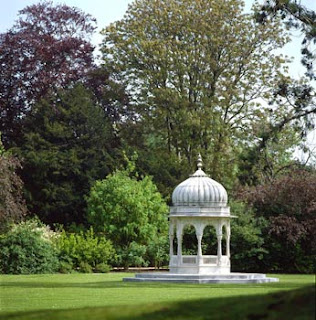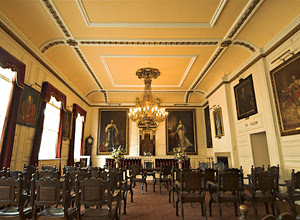Victoria here, inviting you to join Kristine and me on The Wellington Tour, 4-14 September, 2014. For details on our planned itinerary, costs and other info, click here. Among the features of the tour is a visit to Windsor Castle and especially to its Waterloo Chamber.
Windsor Castle from the Thames
The Waterloo Chamber was constructed within the Castle to commemorate the victory of the Allied Armies over the French in the Battle of Waterloo, June 18, 1815. Architect Sir Jeffry Wyattville (1766 – 1840) created the Chamber in 1824 out of several existing rooms. Parliament designated £300,000 for the project. Like most of King George IV’s inspirations, it ran well over budget, eventually costing about £1,000,000. Wyattville also remodeled many other areas of Windsor Castle for George IV, William IV, and Queen Victoria; he was buried in the Castle’s St. George’s Chapel in 1840.
Watercolour of the Waterloo Chamber in 1844 by Joseph Nash
Waterloo Chamber, currently
For a virtual tour of the entire Waterloo Chamber,
click here.
Arthur Wellesley, 1st Duke of Wellington
Commander of the Victorious Allied Armies
The walls of the Waterloo Chamber are filled with large portraits of the leaders of the Allied efforts. Most of them are painted by Sir Thomas Lawrence (1769-1830), the Regency era’s favorite artist. Many were reproduced several times by his studio for numerous placements in other palaces, stately homes and distinguished galleries.
Prussian General Gebhardt von Blücher
Wellington’s Comrade-in-arms at Waterloo
Sir Thomas Lawrence 1816
The Prince Regent (later George IV) commissioned Lawrence to paint all the Allied Sovereigns, military leaders, and statesmen. Lawrence traveled around Europe to complete the portraits.
Austrian Field Marshal Karl Philipp, Prince of Schwartzenberg,
Alexander I, Emperor of Russia (1777-1825)
painted by Sir Thomas Lawrence, 1818
According to the Royal Collection Website, “While working on the portrait Lawrence altered the position of the legs, much to the consternation of the Tzar and those courtiers attending the portrait sitting, especially when for a while the sitter was shown with four legs.” Obviously, this condition was corrected!
Pope Pius VII, 1819-20
The portrait of Pope Pius VII (1742-1823), painted in Rome, is widely agreed to be Lawrence’s masterpiece, both incisive and sympathetic.
While heads of state and leading generals were depicted full length, politicians and statesmen were honored with 3/4 length portraits, perhaps putting them in their place?
Viscount Castlereagh
Sir Thomas Lawrence, 1830
Robert Stewart (1769-1822), Viscount Castlereagh, later second Marquess of Londonderry, served as Secretary of State for War 1805-09, and Foreign Secretary 1812-1822
Robert Banks Jenkinson, 2nd Earl of Liverpool
Robert Banks Jenkinson (1770-1828), 2nd Earl of Liverpool was Prime Minister from 1812 to 1827, and also preceded the Duke of Wellington as the Lord Warden of the Cinque Ports, about which more soon!!
In the words of the Windsor Castle guidebook, “Most of the twenty eight portraits were delivered after his [Lawrence’s] death on 7 January 1830. By this time work was already begun of the space of the Waterloo Chamber created by covering a courtyard at Windsor Castle with a huge sky-lit vault; the room was completed during the reign of William IV (1830-7)…the arrangement which survives to this day: full-length portraits of warriors hang high, over the two end balconies and around the walls; at ground level full-length portraits of monarchs alternate with half-lengths of diplomats and statesmen.”

The limewood carvings on the walls were removed from the former Royal Chapel before it was demolished in the 1820s. The carvings date from the 1680’s, the work of renowned artist Grinling Gibbons. According to the Castle Guidebook, “The Indian carpet was woven for this room by the inmates of Agra prison for Queen Victoria’s Golden Jubilee, finally reaching Windsor in 1894. Thought to be the largest seamless carpet in existence, it weighs two tonnes. During the 1992 fire it took 50 soldiers to roll it up and move it to safety.”
Which brings up a sorrowful subject, the terrible fire of eleven years ago.
20 November, 1992
Extensive damage resulted from the fire though the Waterloo Chamber was only slightly damaged, due to the thickness of the walls. Other areas were destroyed and eventually repaired. To pay for the
£36.5 million repairs, the Queen opened the State Rooms of Buckingham Palace to the Public, but only when she is in residence elsewhere.
When you tour Windsor Castle with Kristine and me, you will see the renovated areas and where the fire burned. And we will view the Waterloo Chamber — and all the State rooms, most of them still very much as they were when redone for George IV by Sir Jeffry Wyattville.
Again to access more information on the Wellington Tour, go to
.


























_by_Thomas_Lawrence.jpg)











